|
2025-02-25
Dyenamo launches a new perovskite-product catagory for dry evaporation
Dyenamo continues to provide innovative materials and initiatives to support the ongoing industrialization of perovskite solar cells by launching a novel product category of materials for dry deposition by evaporation methods, Perovskite evaporation materials. The product selection consists of a novel materials high-purity grade (5NE) and Dyenamo-designed robust SAM-type hole-transport molecular materials. More products in this new category will be launched continuously.
2024-09-16
LAPERITIVO - a European consortium for perovskite modules
LAPERITIVO is a novel Horizon Europe project focusing on the development of large-area stable perovskite solar modules, using processes with high manufacturability. Efficiency targets are 22% and 20% for 900 cm2 opaque and semi-transparent (with >95% bifaciality) modules, respectively. Key research activities include the deposition of high-quality perovskite films as well as contacting layers over large substrate area using industrially viable techniques. Indoor and outdoor field tests, in line with International Electrotechnical Commission (IEC) standards, will be performed to monitor module reliability. Safety, circularity, and sustainability will be assessed to demonstrate products with minimized environmental impact. The developed semi-transparent modules will be applied to perovskite/silicon four-terminal tandem modules and also to agrivoltaics. Moreover, the design of a perovskite PV pilot line of 200 MW and production capacity of 5 GW in Europe will also be explored.
The project is coordinated by IMEC. Dyenamo's role is development and supply of perovskite-chemistry. Apart from IMEC and Dyenamo, the consortium consists of Universita degli Studi di Roma Tor Vergata, Hellenic Mediterranean University, EMPA, Fraunhofer ISE, IPVF, Électricité de France, CNRS, Becquerel Institute, Pilkington, Voltec Solar, TSE Troller, BeDimansional, SmartGreenScan, CSEM, Engie Laborelec, Singulus Technologies and TotalEnergies.
2024-02-08
Dyenamo launches new product category for fullerene acceptors
We continue to broaden our portfolio of high-quality materials for chemistry-based solar cells by launching a novel product category of fullerene acceptors including different purity grades of C60, C70, PCBM, PC71BM and ICBA (Acceptor materials).
2024-01-11
Novel perovskite stability breakthrough molecule in Dyenamo's Perovskite Passivation Initiative
We congratulate our scientific advisor Bowen Yang, our co-founder Anders Hagfeldt and their co-workers for the novel breakthrough publication in Nature Energy on perovskite solar cells, DOI: 10.1038/s41560-023-01421-6. They stabilized the grain boundaries and surfaces of the perovskite layer, resulting in a remarkable stability at efficiencies exceeding 23%. The key material dimethylphenethylsulfonium iodide (DMPESI) is available in our product category for perovskite passivation materials (Perovskite passivation materials, DMPESI).
2023-10-20
Dyenamo introduces the Perovskite Passivation Initiative
Dyenamo's Passivation Initiative is our latest contribution to our continuous efforts to provide chemistry allowing device-manufacturers to improve perovskite solar cells. Our novel product category Perovskite passivation materials comprises molecules that reduce the impact from defects in the perovskite crystals. The product selection of passivation materials will be continuously updated.
2023-09-25
Dyenamo exhibition at the PSCO conference in Oxford 16-18 September 2023
Dyenamo would like to acknowledge the PSCO conference organizers and all the participants for three intense days in Oxford with vivid discussions regarding perovskite solar cells. We return home with great motivation to continue to support the impressive research activities and industrialization initiatives by offering consistent and relevant high-quality materials.
2023-08-09
Dyenamo perovskite salts used to break two world-records for perovskite silicon tandem cells
Breaking solar cell efficiency world-records is a massive challenge requiring optimal quality of all parameters and processes. The two recent Science Magazine articles with world-records for perovskite/silicon tandem solar cells (31.25 % from EPFL's Photovoltaics and Thin Film Electronics Laboratory in collaboration with CSEM and 32.5 % from Helmholtz-Zentrum Berlin) share the common feature of using Dyenamo's perovskite precursor salts. These results, once again, confirm the high quality of our perovskite materials and our relevance to the field. The materials are available in small batch sizes for research, as well as large quantities for production.
2023-06-28
Dyenamo materials open for dye-sensitized single cell open circuit voltage exceeding 1 V at 200 Lux
We congratulate dye-sensitized solar cell researchers at the CSIR-National Institute for Interdisciplinary Science and Technology (CSIR-NIIST), (S. Soman, et al., DOI: 10.1039/d3ta02698a) for obtaining open-circuit voltages well exceeding 1 V at fluorescent light of 200 Lux (1.27 V under standard AM1.5G 1000 W/m2 illumination). Their work is based on combining the Dyenamo dye DN-F22 and a copper (II/I) electrolyte based on the Dyenamo products DN-Cu09 and DN-Cu10 with the implementation of a layer of ZnO hierarchical microstructures over the conventional TiO2 active layer. The results open for single-cell DSSCs, i.e. cells without serial connections or other voltage-increasing solutions, being used in IoT (Internet-of-Things) applications.
2023-05-23
Five further molecular materials from the SAM factory
With the aim to overcome the challenge of low device fabrication yield arising from the wettability issue of most SAM materials, Dyenamo now launches five molecular materials with amphiphilic properties. This is obtained by using MeO-TPA (DN-X27, DN-X30, DN-X34), phenothiazine (PTZ) (DN-X29), and methoxyl substituted carbazole (DN-X32), respectively, as functional moieties. More details could be found on the SAM factory webpage.
2023-04-25
Dyenamo co-founder Prof. Anders Hagfeldt ranked as best Scandinavian researcher in Materials Science
We congratulate our co-founder Prof. Anders Hagfeldt for being ranked as number 1 in Sweden in the new Research.com edition of ranking researchers in the discipline of Materials Science, World's Best Materials Science Scientists: H-Index Materials Science Ranking in Sweden 2023 | Research.com. Moreover, he is ranked as number 85 worldwide. Dyenamo proudly has two top 10 co-founders on the Swedish ranking list, since Prof. Gerrit Boschloo is ranked as number 8.
2023-03-31
Dyenamo introduces the SAM factory
As a consequence of the increased interest and efforts on Self-Assembled Monolayer (SAM) molecular materials for perovskite and organic solar cells, we launch the SAM factory (SAM factory). By offering a broad selection of SAM molecules, we give solar cell researchers and manufacturers the possibility to identify the best SAM materials for their devices. The SAM Factory will continuously launch new materials. Moreover, we will supply the SAM molecular materials in smaller or larger amounts, depending on the customer needs, and we will cater SAM requests on demand.
2023-03-30
Dyenamo broadens the portfolio of perovskite precursor materials
Four novel ammonium salts for perovskite precursors have been introduced to our perovskite precursor collection; Octylammonium iodide (DN-P35), Ammonium iodide (DN-P36), Ethylammonium iodide (DN-P37) and Dimethylammonium iodide (DN-P38). The four cations are also available on demand (Cl- and Br-) with different halide anions, such as bromide and chloride. Our full collection or perovskite precursors can be found here (Perovskite precursor materials).
2023-02-27
Dyenamo broadens the portfolio of self-assembled monolayer (SAM) hole transport materials
In our constant ambition to pave the way for researchers and industry within the field of chemistry-based solar cell, we launch two further self-assembled monolayer (SAM) hole transport materials suitable for perovskite and organic solar cells; 4PACz (DN-X15) and 3PACz (DN-X16), both designed to deliver performance similar to Me-4PACz (DN-X10) at lower cost.
2022-12-07
DIAMOND - a European consortium for creating competitive perovskite solar cells with carbon back contact
DIAMOND ('Ultra-stable, highly efficient, low-cost perovskite photovoltaics with minimised environmental impact') is a three-year project funded by the European Commission targeting perovskite PV combining highest efficiencies, ultra-high stabilities, lowest cost and minimised ecological impact. The project comprises 12 European partners (four SMEs, six Universities and two research institutes) from seven countries and is coordinated by Fraunhofer ISE. Dyenamo is the industrial chemistry partner primarily involved in perovskite and charge-transport layers including hole conductors and carbon back contacts.
2022-11-29
SUNREY - a European consortium for improved materials for perovskite solar cells
SUNREY ('Boosting sustainability, reliability and efficiency of perovskite PV through novel materials and process engineering') is a three-year project co-funded by the European Commission targeting improved perovskite solar cells via materials and process engineering. The project comprises 13 European partners from nine countries and is coordinated by Fraunhofer IAP. Dyenamo is the industrial chemistry partner primarily involved in perovskite and hole conductor materials.
2022-11-23
PEPPERONI - a European consortium for creating a perovskite-silicon tandem device pilot line
PEPPERONI ('Pilot line for European production of perovskite-silicon tandem modules on industrial scale') is a four-year project co-funded by the European Commission covering the full value chain of PV innovation to set up a perovskite-silicon tandem device pilot line at Qcells in Germany. Apart from the module manufacturer, the consortium includes industrial equipment suppliers, industrial material suppliers, leading research groups on perovskite and silicon device and experts on environmental, social and economic evaluations of novel PV technologies. The project comprises 17 European partners and is coordinated by Helmholtz-Zentrum Berlin and Qcells. Dyenamo is the industrial chemistry partner for the perovskite devices.
2022-10-28
Dyenamo materials in DSSC efficiency-record publication from EPFL
We congratulate dye-sensitized solar cell researchers at EPFL (Ren et al., DOI: 10.1038/s41586-022-05460-z) for obtaining a conversion efficiency of 15.2% under standard AM1.5G 1000 W/m2 illumination. Their work is based on improved prerequisites for co-sensitizing two dyes by pre-adsorbing a monolayer of a derivative of hydroxamic acid on the TiO2. This monolayer enables the formation of a well-ordered and densely packed layer of sensitizer. The co-sensitizing was made with two novel dyes named SL-9 and SL-10 (these dyes can be pre-ordered at Dyenamo by sending a message to info@dyenamo.se). The dyes were used in combination with a copper (II/I) electrolyte based on the Dyenamo products DN-Cu09 and DN-Cu10.
2022-10-14
TRIUMPH - the first European consortium on triple junction perovskite/perovskite/silicon cells
TRIUMPH ('Triple junction solar modules based on perovskites and silicon for high performance, low-cost and small environmental footprint') is a 3.5 years project funded by the European Commission aiming at paving the way for a future PV cell technology, based on an advanced triple junction cell concept. The devices will be based on perovskites for the middle and top cells and silicon for the bottom cell. The consortium, coordinated by IMEC in Belgium, consists of additional 14 complementary partners from both research institutions and industry. Dyenamo is the industrial chemistry partner of the project.
2022-09-26
Dyenamo launches a new perovskite layer additive and a new hole conductor
Formadinium formate (DN-P24), is an additive to perovskite precursors that allows efficient suppression of anion vacancy defects at grain boundaries and on the surface of the perovskite film. Also, a new hole conductor MeO-2PACz, (DN-X13), which is a carbazole-based system with phosphonic acid as anchoring group enhancing the formation of self-assembled monolayers on oxide surfaces.
2022-06-07
Dyenamo low-temperature carbon paste used in perovskite devices from Fraunhofer ISE with efficiency value of 18.5%
We congratulate researchers at Fraunhofer ISE for obtaining a perovskite conversion efficiency of 18.5% by using Dyenamo's low-temperature carbon paste (DN-CP01)
in combination with a 2D-Perovskite as an electron blocking layer (DOI: 10.1002/aenm.202200837). Their work, a result of the project UNIQUE supported under SOLARERA.NET, confirms the quality of our carbon paste and demonstrates a scalable route to low-cost perovskite solar cells.
2022-01-07
Dyenamo launches two red-shifted variants of the XY1b dye
The Dyenamo-developed DSSC dyes XY2b (DN-F23B) and XY3b (DN-F24B) are both red-shifted variants of the popular and high-performing dye XY1b (DN-F16B) opening for increased light-absorption for indoor and outdoor applications.
2021-11-15
Dyenamo launches two more perovskite precursors for improved device performance and stability
In our constant ambition to pave the way for researchers and industry within the field of chemistry-based solar cells, we now launch two perovskite precursors for improved device performance and stability; Benzylammonium thiocyanate (DN-P31)
and Cyclohexylethylammonium iodide (DN-P32, DOI: 10.1021/acsenergylett.1c01811.)
2021-11-11
Scientific Advisor Appointed
Dyenamo is pleased to announce that Dr Bowen Yang has been linked to the company as Scientific Advisor. She is well-known to Dyenamo after our collaboration in the EU-funded perovskite solar cell project ESPResSo (Efficient Structures and Processes for Reliable Perovskite Solar Modules). After three years in the research group of Prof. Anders Hagfeldt at EPFL, she has joined Prof. Gerrit Boschloo's research group at Uppsala University.
2021-10-01
Dyenamo hole conductor X55 improves efficiency and stability in perovskite solar cells
Dyenamo congratulates researchers at CHOSE-Centre for Hybrid and Organic Solar Energy at the University of Rome "Tor Vergata", for demonstrating the advantages of the Dyenamo hole conductor X55 (DN-X07) in perovskite solar cells. X55 improves both device efficiency and stability in relation to the commonly used reference material Spiro-OMeTAD, DOI: 10.3390/en14196081. In addition, X55 is readily scalable and Dyenamo is prepared to supply the material in required quantities for industrialization.
2021-10-01
Novel review on the development and status of dye-sensitized solar cells
We want to highlight the publication "Dye-sensitized solar cells strike back", DOI: 10.1039/d0cs01336f, a thorough review of the development and status of dye-sensitized solar cells. The observant reader may notice that the title has been borrowed from the memorable Dyenamo conference "DSSC strikes back", in Uppsala 2017.
2021-09-22
Free online workshop on perovskite solar cells 29 September 2021 - outcome from the European Commission funded project Espresso
The three-year Horizon 2020 project Espresso (Efficient Structures and Processes for Reliable perovskite Solar modules) is coming to an end. On the 29th of September, 10am - 1pm (CET), the consortium will present the outcome of the activities. The Espresso organizations are coordinator IMEC (Belgium), EPFL (Switzerland), CHOSE - University of Rome "Tor Vergata", CNR and CSGI (Italy), Fraunhofer (Germany), University of Cyprus, Dycotec and M-Solv (UK), Onyx (Spain), Corning (France), Saule (Poland) and Dyenamo.
The event is free of charge. If you would like to join, please register by latest 28 September 2021 by sending a message to conference@dyenamo.se.
2021-06-04
Dyenamo carbon paste used in perovskite devices with efficiency value exceeding 20 %
We congratulate researchers at Alagappa University for obtaining a perovskite conversion efficiency of 20.35 % by using Dyenamo's low-temperature carbon paste DN-CP01 in combination with an electrodeposited layer of CuI@CuSCN as hole transport material
(K. Ramachandran et al., DOI: 10.1016/j.jallcom.2021.160530). This is, as far as we know, the highest efficiency value obtained for carbon-based perovskite solar cells, confirming the quality of our carbon paste and demonstrating a scalable route to low-cost perovskite solar cells.
2021-05-20
Dyenamo launches self-assembled monolayer hole conductor for organic solar cells
As a continuation of our collaboration with Kaunas University of Technology, we are happy to launch the patented Self-Assembled Monolayer (SAM) hole conductor Br-2PACz, that was used to obtain an impressive 18.4 % efficiency for organic solar cell (OPV), DOI: 10.1002/cssc.202100707. This is Dyenamo's first product that has been specifically developed for OPVs.
2021-05-05
Dyenamo materials in DSSC efficiency-record publication
We congratulate dye-sensitized solar cell researchers at EPFL (D. Zhang et al., DOI: 10.1038/s41467-021-21945-3) for obtaining a conversion efficiency of 13.5 % under standard AM1.5G 1000 W/m2 illumination, and 34.5 % at 1000 lux from fluorescent illumination. Moreover, we proudly conclude that Dyenamo-materials were key parameters in their work. By co-sensitizing the Dyenamo dye DN-F16B (XY1b) with the novel dye coded MS5 (now available at Dyenamo as DN-F22), they managed to boost the voltage output of the device by retarding the recombination of charge carriers generated by light. The dye combination XY1B/MS5 was used in combination with a copper (II/I) electrolyte based on the Dyenamo products DN-Cu09 and DN-Cu10. This work is yet another confirmation that our efforts in providing state-of-the-art materials for chemistry-based solar cells contribute to advances in chemistry-based solar devices.
2021-04-27
Dyenamo co-organizes online conference
We are proud to co-organize the first International Solar Power Technologies (SPTech) Conference, hosted by the University of Porto. The event, that has been tailormade by scientists for scientists, is free of charge and takes place 5 to 8 July 2021. It covers four topics; i) Solar Fuels and Storage Technologies, ii) Dye-Sensitized Solar Cells, iii) Perovskite Solar Cells and iv) Solar Energy Policy. We encourage you to read more, to register and to submit your abstract.
For more information, visit the website: International Conference on Solar Power Technology (solar-power-tech.com)
2021-01-15
Dyenamo signs license agreement with Helmholtz-Zentrum Berlin and Kaunas University of Technology
We are very pleased to announce that we have signed a license agreement with Helmholtz-Zentrum Berlin and Kaunas University of Technology for commercialisation of their self-assembly monolayer hole conductor materials 2PACz and Me-4PACz. These materials, in combination with our high-purity perovskite salts DN-P09-4N and DN-P10-4N, played key roles in obtaining a world-record conversion efficiency of 29.15 % in a monolithic perovskite/silicon tandem solar cell (DOI: 10,1126/science.aba3433). This is a great example of how Dyenamo combines contributing to world-class research and providing easy access to state-of-the-art materials for chemistry-based solar cells.
2020-10-26
Dyenamo launches new interface passivator for perovskite solar cells
4-tert-butyl-benzylammonium iodide (DN-P21) is an interface passivator for perovskite solar cells that can significantly accelerate the charge extraction from the perovskite materials into the hole-transporters and reduce device hysteresis as well as improve the device performance and stability.
Dyenamo offers two high-purity grades of 4-tert-butyl-benzylammonium iodide; >99.9 % (grade 3N) and >99.99 % (grade 4N).
2020-10-06
Science-publication from EPFL opens for new development routes for perovskite solar cells
We congratulate researchers at EPFL for obtaining a perovskite solar cell conversion efficiency of above 23 %, with low photovoltage loss (330 mV) and electroluminescence above 6% (Lu et al. Science Vol. 370, Issue 6512, eabb8985). The results are based on the discovery that the δ-phase can be completely converted to the targeted α-FAPbI3 at 100°C using a MASCN or FASCN vapor treatment method. Dyenamo offers the key components FAI (DN-P10), FASCN (DN-P13) and MASCN (DN-P12) as part of our high-purity perovskite salts.
2020-08-26
Dyenamo launches new perovskite precursor
Formamidinium chloride (DN-P22) is a perovskite precursor opening for further optimization of crystallization, grain size and surface morphology of the perovskite layer. In mixed halide perovskite solar cells, the addition of formamidinium chloride has shown to suppress the formation of bulk and surface defects, providing a perovskite film with enhanced crystallinity and large grain size.
As with our other perovskite precursors, Dyenamo offers two high-purity grades of formamidinium chloride; >99.99 % (grade 4N) and >99.999 % (grade 5N).
2020-07-20
Dyenamo carbon paste used to improve thermal and moisture stability of perovskite solar cells
We compliment the team from University of Rome Tor Vergata (Calabrò et al., DOI: 10.1021/acsami.0c05878) for achieving enhanced thermal and moisture stability of perovskite solar cells by stabilizing the perovskite structure in combination with using Dyenamo's carbon paste DN-CP01.
2020-06-04
Dyenamo carbon paste in flexible inverted stable perovskite solar cells with 15 % efficiency
We congratulate the Saule team for developing an inverted (p-i-n structure) flexible stable perovskite solar cell with 15 % efficiency (Babu et al., "Improved stability of inverted and flexible perovskite solar cells with carbon electrode", ACS Appl. Energy Mater., DOI: 10.1021/acsaem.0c00702). Moreover, we proudly conclude that the Dyenamo low-temperature carbon paste DN-CP01 plays an important role in their work.
2020-06-03
Highlights from Dyenamo's fourth thematic online workshop 3 June 2020
Our fourth online workshop with the theme "Hole conductors for perovskite solar cells" gathered appr. 90 registered participants from 17 countries. After an opening by Dyenamo's CEO Henrik Pettersson and a technical introduction to the theme by Dyenamo's HTM-expert Bo Xu, the five speakers presented.
Henk Bolink, University of Valencia, discussed vacuum-deposited, doped and undoped, hole transport materials for the p-i-n and the n-i-p structures, respectively. He highlighted that smooth perovskite films open for thin HTM layers (<50 nm). Starting from their early work, he took us to the recent results with efficiencies up to 21.7 % using the HTM TaTM (DN-X11) and the dopant F6-TCNNQ (DN-P20).
Artiom Magomedov from Kaunas University of Technology presented results on their development of monolayer hole-selective contacts for efficient perovskite solar cells. This approach leads to reduced material consumption while ensuring very high efficiency of 20.9 % in p-i-n devices, and 29.2 % in Si/perovskite tandem solar cells using the HTM monolayer called 2PACz (DN-X09).
Samrana Kazim BCMaterials-Basque center for materials, applications & nanostructures, in Spain presented methodology and results from their studies of molecular designing of hole-selective layers, divided into triaxtruxene-based HTMs, cyclopentadithiophene-based HTMs, Zn-pthalocyanine dopants and a novel hydrophobic p-type dopant, respectively.
Jangwon Seo from Korea Research Institute of Chemical Technology (KRICT) emphasized the role of dopants and presented results showing that Li-complexes should be avoided due to the fact that Li+ ions easily migrate into the perovskite and deteriorate the device performance. To address this issue, he proposed sodium bis(trifluoromethanesulfonyl)imide (Na-TFSI), that has improved both the efficiency and the stability of perovskite solar cells.
Esmaeil Sheibani from the University of Isfahan discussed the impact of three-dimensional, planar and linking topology of hole transporting material. He presented a new class of asymmetric structures and discussed the fundamental understanding of the influence of sulfur and oxygen group substitutions. Champion efficiencies above 18 % were obtained.
Collectively, the speakers demonstrated the fast development of the perovskite field in general, and hole conductors in particular. Once again, the arrangement worked very efficiently thanks to the motivated participants, excellent talks, interesting questions/discussions and a professional moderator. Many thanks to everyone involved!
The fifth thematic workshop is a status report of the EU-funded project Espresso, which will take place on the 16 June 2020. Thereafter, we take a break to evaluate the events.
2020-05-26
Dyenamo launches passivator for perovskite solar cells
4-tert-butyl-benzylammonium iodide (DN-P21) is an interface passivator for perovskite solar cells that can significantly accelerate the charge extraction from the perovskite materials into the hole-transporters and reduce device hysteresis as well as improve the device performance and stability.
2020-05-21
Highlights from Dyenamo's third thematic online workshop 20 May 2020
Our third online workshop with the theme "Dye-sensitized solar fuels" gathered appr. 60 registered participants from 12 countries, and five speakers. Here are a few highlights:
Licheng Sun, who recently has taken on a new position at Westlake University in Hangzhou in parallel to his activities at KTH in Stockholm, gave an introduction to the topic. Thereafter, he presented results from visible light driven water splitting based on Ru-dyes-sensitized TiO2 based photoanodes, and discussed key factors influencing the cell performance emphasizing the importance of how strong the catalyst is anchored to the electrode surface.
Murielle Chavarot-Kerlidou from the SolHyCat team at Université Grenoble Alpes/CNRS/CEA Grenoble presented their strategy for and results on functional H2-evolving dye-sensitized NiO photocathodes relying either on covalent dye-catalyst assemblies or on the co-immobilization of the molecular dye and catalyst components.
Elizabeth Gibson presented highlights from recent work on Dye-sensitized photocathodes for photoelectrochemical devices to generate H2 at Newcastle University. She focused on kinetics measurements and interpretations from systematic variations of dye molecules and catalysts immobilized mainly on NiO photocathodes.
Haining Tian discussed the strategies used at Uppsala University in order to improve the performance of Dye-sensitized Photocathodes by focusing on the current production of the photocathode. He emphasized that the molecular dye design and the device engineering are key parameters to address these factors.
Julien Warnan from the Technical University of Munich presented results and experiences from their recent efforts to demonstrate a water-based colloidal dye-sensitized solar fuel approach. He presented the design and properties of various dyes, including enzyme systems, in order to achieve unassisted solar-driven water-splitting into H2 and O2.
Collectively, the speakers demonstrated a field in fast development with interesting scientific challenges and a promising future. Once again, the arrangement worked very efficiently thanks to the motivated participants and excellent talks sharing results and pointing out future development routes. Many thanks to everyone involved!
Encouraged by this and previous workshops, we have already announced the fourth and fifth ones in the series with the topics hole conductors and a status report of the EU-funded project Espresso, respectively.
2020-04-22
Highlights from Dyenamo's second thematic online workshop 22 April 2020
Our second online workshop with the theme "Dye-sensitized solar cells using Cu-based redox mediators" gathered appr. 75 registered participants from 15 countries. Once again, we were astonished by the great response to the initiative. After a technical introduction to the topic by Dyenamo, four presentations were given. Here are a few highlights:
Marina Freitag, who recently has moved from Uppsala to Newcastle University, gave an overview of the field and presented her work on liquid and solid-state Cu-based DSS devices. By combining the two sensitizers, coded XY1 (DN-F16) L1 (DN-F02), with the copper complex Cu(II/I)(tmby) (DN-Cu09 and DN-Cu10) as a redox shuttle, record-values were obtained at low-light conditions; open-circuit photovoltage of 1.1 V and power outputs of 18 and 103 µW/cm2 at 200 and 1,000 lux, respectively, corresponding to a device efficiency of 34.0%.
Suraj Soman from CSIR-NIIST in India presented a direct comparison between DSSCs using copper and conventional electrolytes (cobalt and iodine) revealing the higher photoconversion efficiencies for the copper-based ones. His talk moreover gave an exciting overview of his activities, ranging from fundamental work to module and pilot-line developments, emphasizing that the ideality factor is higher for Cu-complexes than for the other redox mediators. This requires further studies, in particular the interaction between Cu-complexes and TiO2 surface states. The equipment for module fabrication was developed and installed in Dr. Soman's lab by Dyenamo's partner Elixir Technologies.
Yuhang Liu presented results from EPFL, emphasizing the importance of the photo-absorbing dye and the possibility to further improve the devices by dye modifications. Cu-based DSSCs produce high photovoltage due to their low-lying highest occupied molecular orbital (HOMO) level. Record photovoltages above 1.15V was obtained. Design rules to keep the HOMO level fixed but lowering the LUMO level to redshift the absorption spectrum were presented. Dr. Liu also discussed the development of dyes, WS-70 and WS-72 (DN-F18), for Cu-complex based solid-state DSSCs (zombie-cells) giving record solid-state efficiencies of 11.7%.
Ghufran Hashmi, who presently is in transfer from Aalto to Oulu University in Finland, focused on the counter electrode of Cu-based DSSC devices. He presented promising results with carbon counter electrodes. To measure charge transfer resistances of counter electrodes he presented impedance spectroscopy measurements and the equivalent circuits used. He encouraged the use of sandwich cells assembled by two counter electrodes for such measurements. Moreover, he highlighted the possibility to selectively apply the dye and electrolyte solution with inkjet printing.
We want to thank all the speakers and participants for excellent talks sharing results and pointing out future development routes. We also want to express our gratitude for all the endorsements and positive feedback that we have received for the arrangement. The planning of the third workshop is in progress, more information will be available on our web within shortly.
2020-04-08
Highlights from Dyenamo's first thematic online workshop 8 April 2020
Our first online workshop with the theme "Perovskite solar cells using carbon paste DN-CP01" included four presentations and gathered appr. 40 participants from nine countries. We were astonished by the response considering the fact that it was arranged with such short notice. Here are a few highlights from the presentations:
Konrad Wojciechowski reported on Saule's work on using the carbon paste for the p-i-n device structure. The results were impressive with flexible device efficiencies >15 % (1 cm2) with excellent operational (maximum power point) and thermal (85 °C) stability of the devices over 1000 hours of aging.
Bowen Yang from EPFL presented n-i-p device efficiencies around 13 % with good stability under dark condition using DN-CP01. Moreover, she highlighted the necessity and challenge involved in identifying suitable interlayers between perovskite and carbon in order to further improve the device performance.
Lukas Wagner from Fraunhofer ISE, presented initial results from their work on low-temperature perovskite cells using DN-CP01. High photovoltages above 1V and device efficiencies around 12 %, limited by low fill-factor, were presented for the n-i-p structure.
Gerrit Boschloo, Uppsala University, highlighted the importance of introducing a hole-selective layer between the perovskite and the carbon in n-i-p devices. The device efficiencies increased from 12 % to almost 15 % by such measures.
We want to thank all the speakers and participants for excellent talks sharing technical details, successes and obstacles, and for strong engagement and vivid discussion. The next workshop will be held on the 22nd of April 2020 with the theme "DSSC using Cu-based redox mediators", more information will be available on our web within shortly.
2020-03-25
Dyenamo web-workshop No.1 - Perovskite solar cells using carbon paste DN-CP01
Difficult times lead to unconventional ideas. As face-to-face conferences suddenly is a faraway option, Dyenamo would like to test an alternative platform for information exchange. We would like to try out thematic online workshops. The first one will be organized Wednesday 8 April from 9.00 Swedish time and cover the topic Perovskite solar cells using the Dyenamo carbon paste DN-CP01. The event is free of charge and will be organized via Zoom. The following speakers are already confirmed:
Konrad Wojciechowski, Saule S.A.
Fuguo Zhang, KTH
Bowen Yang, EPFL
Lukas Wagner, Fraunhofer ISE
Gerrit Boschloo, Uppsala University
In addition to these speakers, our plan is to have up to five additional presentations. In case you are interested in presenting your work using the Dyenamo carbon paste DN-C01 (15 minutes), we kindly ask you to submit a very short abstract (title + 3-4 sentences about the work) before 31 March 2020 by sending a message to us. We will thereafter quickly select the contributions and inform you.
For registration, please write your name and organisation in an email, by latest 6 April 2020. We will confirm your registration by sending the link to the event.
2020-03-19
Dyenamo materials in DSSC efficiency-record publication, 34 % at 1000 lux from fluorescent light
We congratulate dye-sensitized solar cell researchers at Uppsala University (Michaels et al., DOI: 10.1039/c9sc06145b) for obtaining a conversion efficiency of 34 % at 1000 lux from fluorescent illumination. Moreover, we proudly conclude that the organic dyes XY1 (DN-F16) and L1 (DN-F02) from Dyenamo were key parameters in their work. By combining co-sensitization of these two dyes with an electrolyte based on the Cu-based redox couples DN-Cu09 and DN-Cu10, they managed to maintain a high cell-voltage at low-light conditions. This work is yet another confirmation that our efforts in providing state-of-the-art materials for chemistry-based solar cells contribute to advances in DSSC devices.
2020-01-30
Dyenamo launches new reference dye for p-type dye-sensitized solar cells
For many years, the dye DN-FP01 (P1) has served as reference dye for p-type dye solar cells. We are now pleased to launch the dye DN-FP02 (PB6), a
p-type dye utilizing a triphenylamine as electron donor, perylene monoimide as electon acceptor and thiophene unit as linker. In contrast to the P1 dye, the oxidation and reduction absorption of this dye can be well separated. In addition, excellent electrical and optical properties and proven stability at elevated temperatures make the dye an obvious candidate for becoming the new reference dye for p-type DSSC.
2020-02-03
Dyenamo launches three new hole conductors and one dopant for p-i-n perovskite solar cells
In our constant ambition to pave the way for researchers and industry within the field of perovskite solar cells, we now launch an updated website for hole conductors, one of the key components of perovskite solar cells. Apart from four new products (the hole conductors 2PACz, DFH and TaTm as well as the p-type dopant F6-TCNNQ), this includes a comprehensive overview of the energy levels and the most suited device concepts (n-i-p, p-i-n or ss-DSSC) for the products.
2020-01-30
Dyenamo launches new reference dye for p-type dye-sensitized solar cells
For many years, the dye DN-FP01 (P1) has served as reference dye for p-type dye solar cells. We are now pleased to launch the dye DN-FP02 (PB6), a
p-type dye utilizing a triphenylamine as electron donor, perylene monoimide as electon acceptor and thiophene unit as linker. In contrast to the P1 dye, the oxidation and reduction absorption of this dye can be well separated. In addition, excellent electrical and optical properties and proven stability at elevated temperatures make the dye an obvious candidate for becoming the new reference dye for p-type DSSC.
2019-12-03
Dyenamo launches start-up kits for manufacturing perovskite solar cells and low-power DSSC
Research on perovskite solar cells and industrialization of dye-sensitized solar cells for low-power applications are booming. There is a massive interest to enter both fields. However, it is well-known that such chemistry-based solar cell technologies are difficult in practice and that it takes a lot of experience to obtain reproducible well-performing devices. In addition, several expensive pieces of equipment, such as the glovebox for perovskite devices, may create an entrance hurdle to the field for many laboratories. In our continuous ambition to pave the way for researchers and companies, Dyenamo has developed economic start-up kits for perovskite and low-power dye sensitized solar cells, respectively. These kits include all necessary pieces of equipment and materials and a thorough manual for device fabrication. For more details, click here.
2019-10-18
The second Dyenamo DSSC conference - confirmation of a new phase for dye-sensitized solar cells
Two years after the memorable "DSSC strikes back" conference, Dyenamo re-gathered students, scientists, companies and engineers from around the world to meet, exchange ideas and their latest DSSC findings. Collectively, the 106 participants from 20 countries made a firm statement that DSSC has entered a new phase where efficiency-records are broken for all device types (opaque, "zombie", see-through, solid-state etc. at both indoor and solar radiation) and that the dream-target of 15 % at full sun now is within reach, and that technology commercialisation is rapidly advancing for IoT and consumer electronics applications (e.g. various sensors, electronic curtains, headphones, solar tables) confirmed by the involvement of high-tech investors (e.g. Softbank) and end-users (e.g. JBL).
We are grateful and humble for all the endorsement for the arrangement. Positive and engaged participants made it very easy to organize things. Thank you to everyone involved! Below please find some memories from the event (photo Louise Seregard).
1 / 6
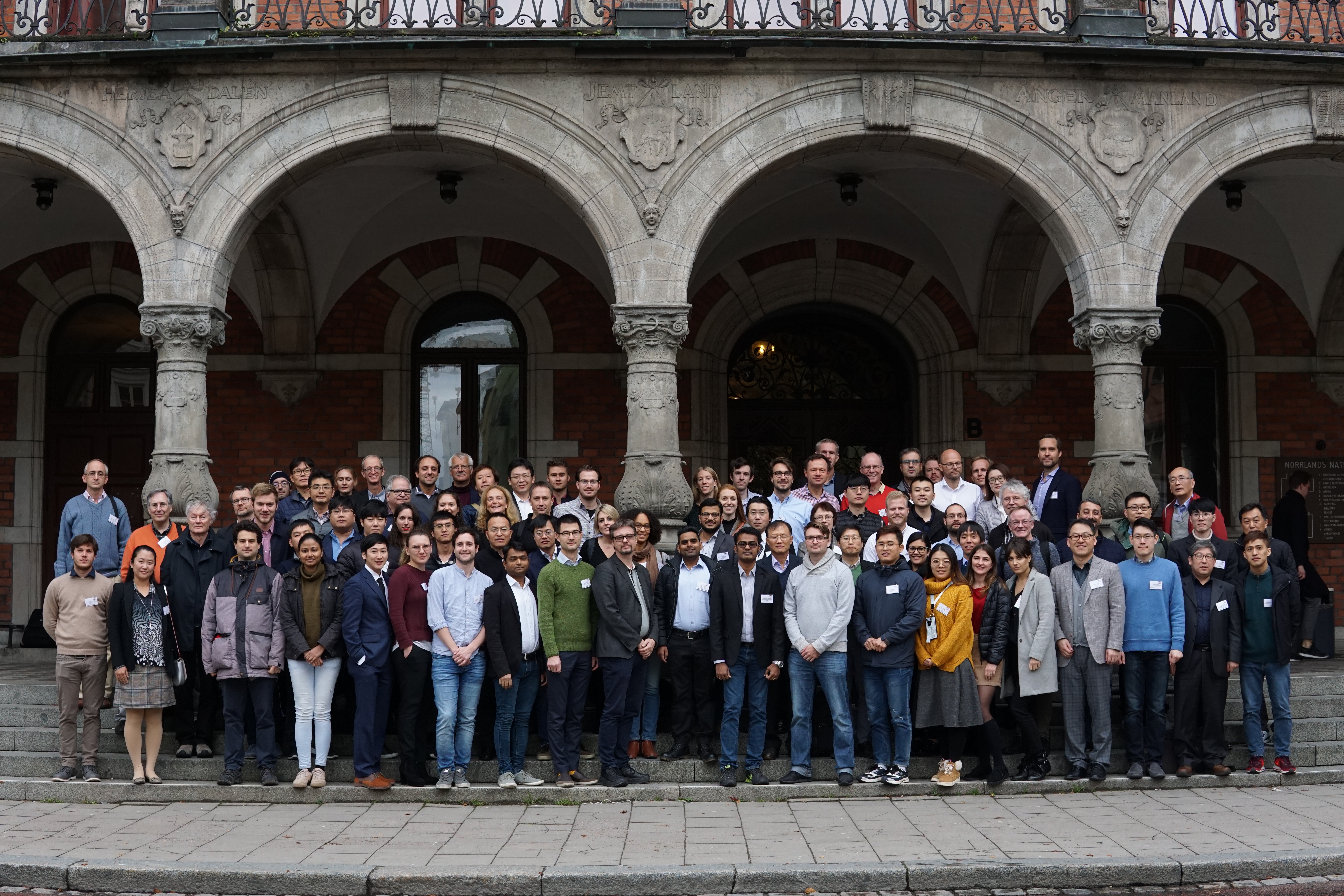
2 / 6
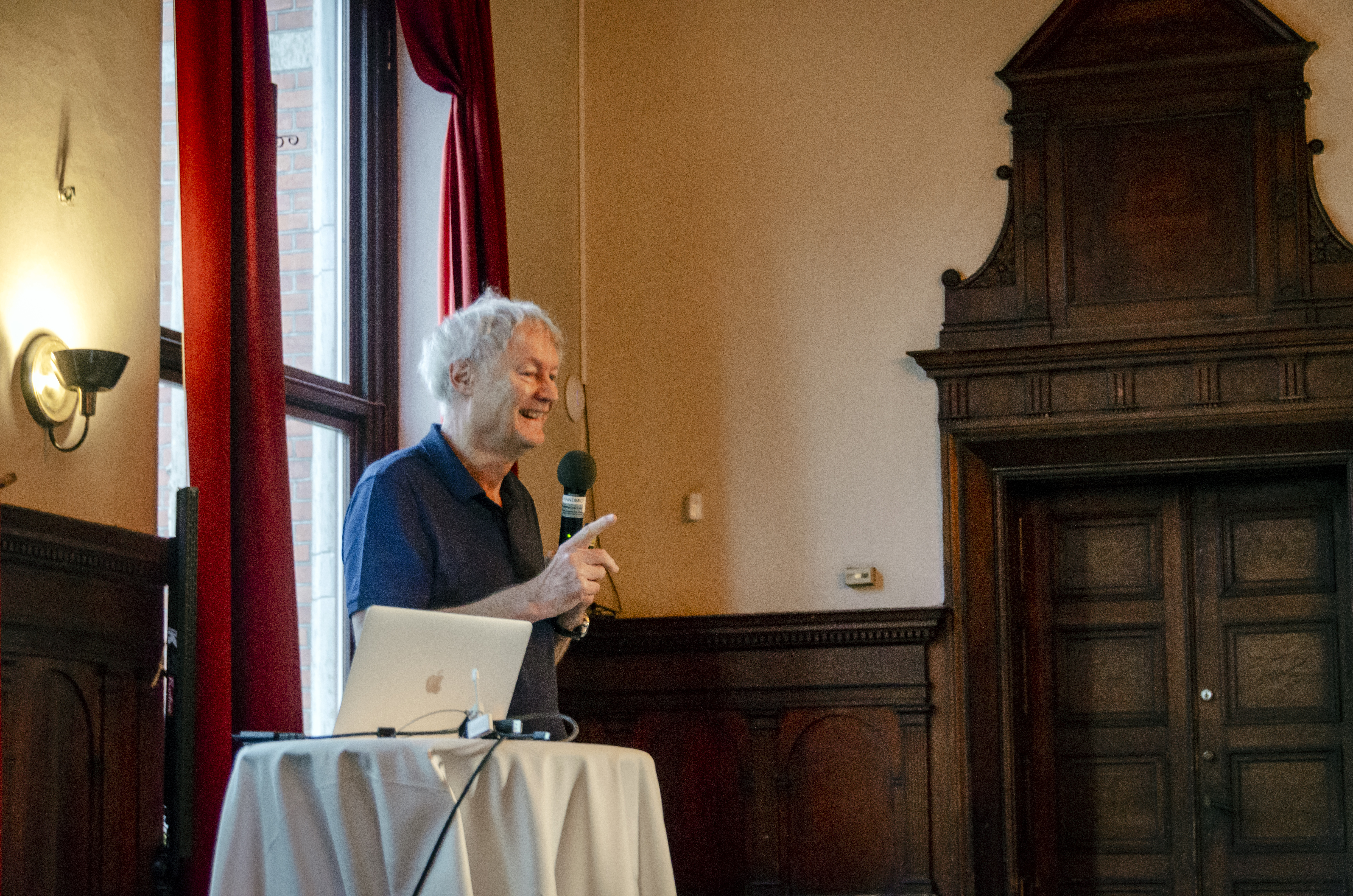
3 / 6
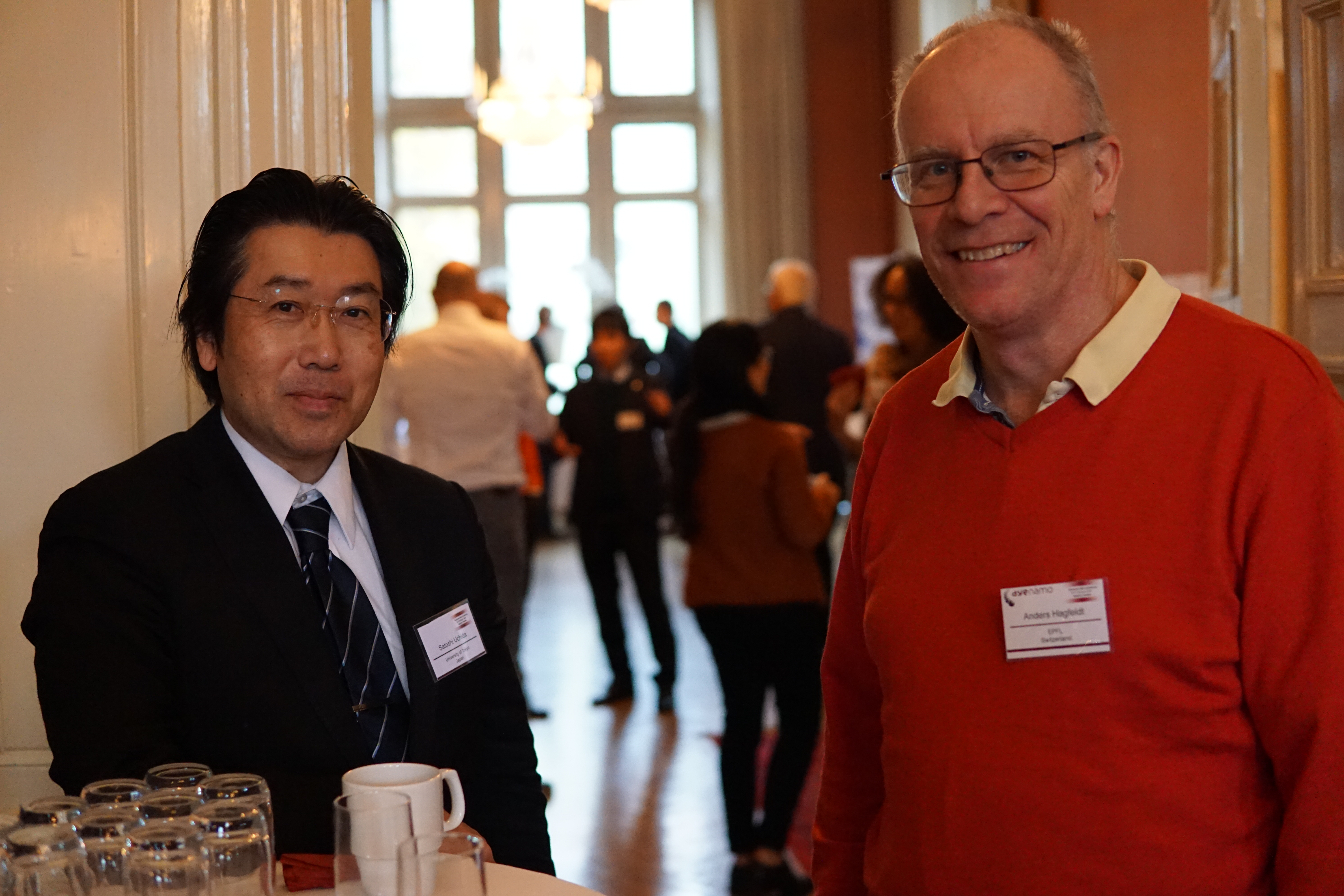
4 / 6
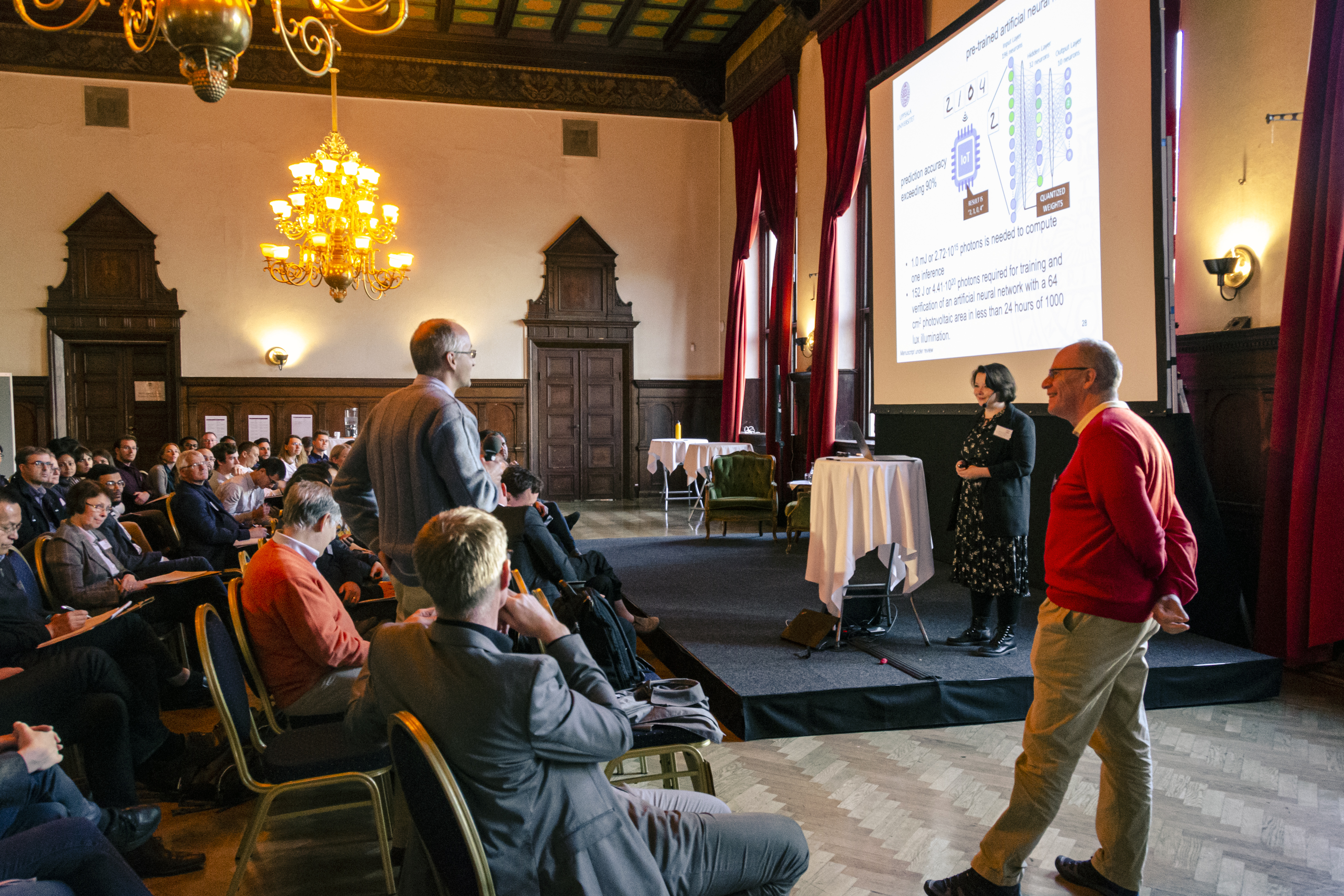
5 / 6
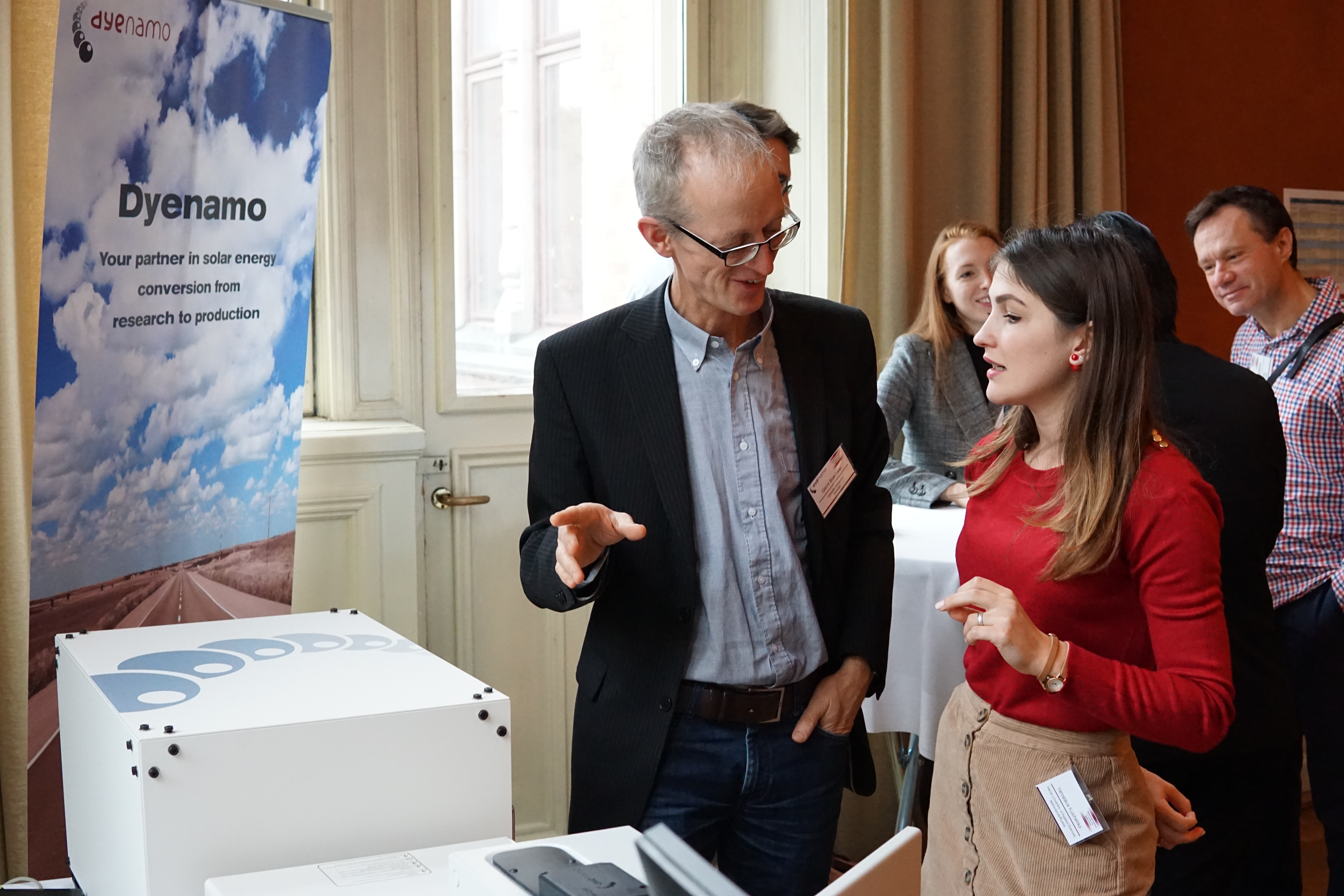
6 / 6
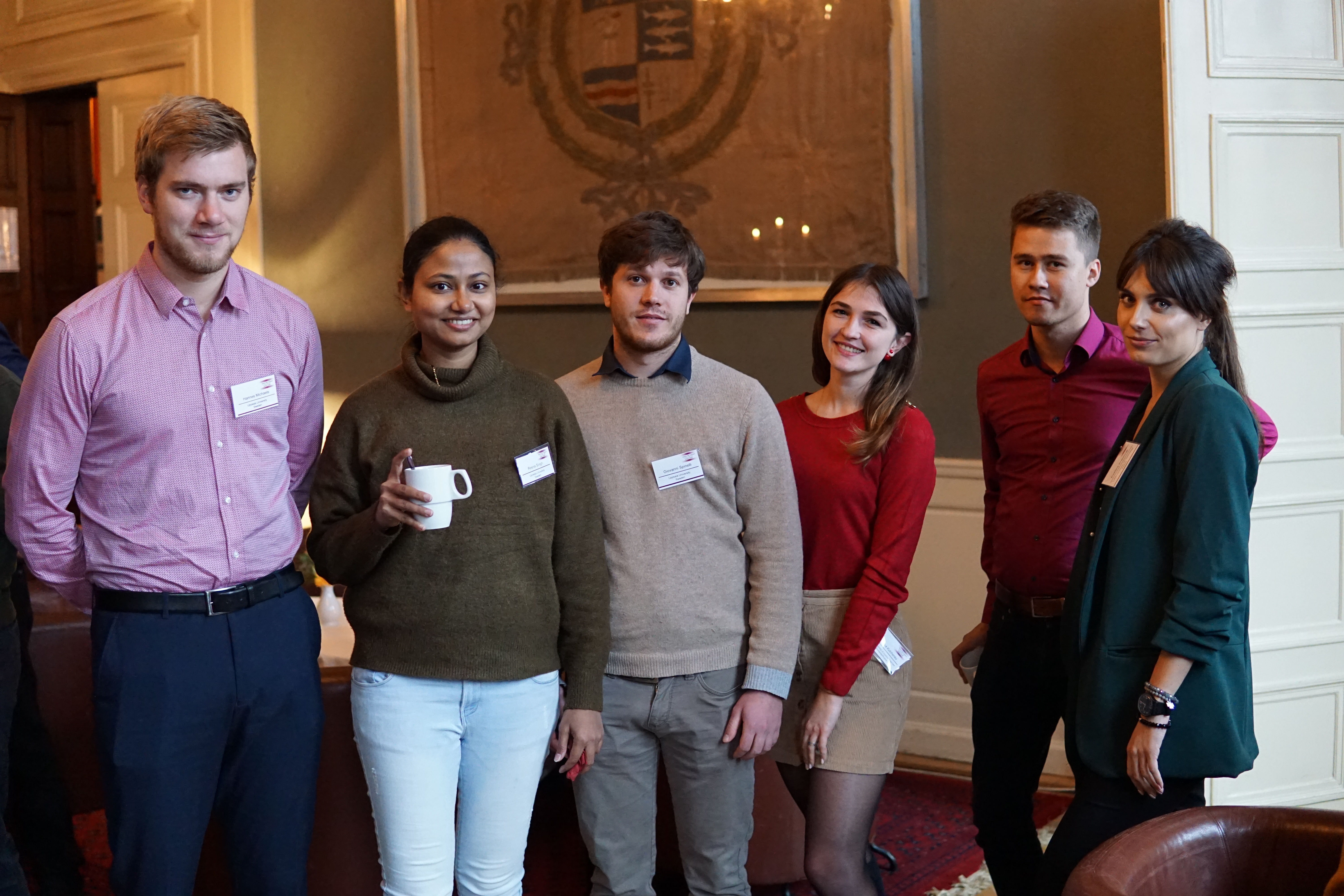
←
→
2019-10-09
The first European consortium on carbon-based perovskite cells
Dyenamo is happy to be the industrial chemistry-partner in the project "Carbon Based Perovskite Solar Cells with Uni-Directional Electron Bulk Transport: in the quest of a Short Time to Market" (UNIQUE). It is the first European consortium dedicated to carbon-based perovskite solar devices with the ambituous target to develop a competitive new-generation photovoltaic technology, characterized by small investment cost and unique posibilities for local production. The three-year project gathers nine partner from seven European countries. The Swiss module-manufacturing company Solaronix is supported by Dyenamo, two research institutes (Fraunhofer ISE and CEA, France) and five academic groups (EPFL in Switzerland, CHOSE-University of Rome “Tor Vergata”, University of Savoie Mont Blanc, Swansea University and University of Madrid).
2019-09-04
Dyenamo launches high-purity MAI with 1500 ppm phosphite
In our ongoing efforts to pave the way for perovskite researchers and industry, we launch a special grade of methylammonium iodide (MAI) containing a controlled amount of phosphite as an additive. Phosphites play an essential role in the crystallization of methylammonium lead iodide perovskites by acting as nucleation centers which, at low concentrations, aid in the formation of high quality films with large grain sizes. Control over the phosphite content is crucial for both the reproducibility and performance of MAPI-based devices. Custom phosphite concentrations are available on demand, please contact us for more information.
2019-08-19
Conference program published online
The program for the 2nd Dyenamo DSSC conference can now be found online. It contains 31 oral and 28 poster contributions from prestigious academic and industrial DSSC experts from all over the world.
2019-05-08
Dyenamo takes the perovskite precursor salts to the next purity level
We are proud to introduce the market-leading purity grade 99.999 % (trace elements basis) for our standard perovskite precursor salts MAI, FAI, MABr and FABr. These materials will be added to our portfolio of high-purity perovskite salts whose shelf lives have been dramatically improved by a new external barrier ensuring minimum water penetration.
2019-04-10
Promotion: 10 % discount and immediate delivery for glass cutters and screen printers
As requested by our customers, we now have a number of glass cutters (DN-HM14) and manual screen printers (DN-HM02) for immediate delivery. In addition, we offer a 10 % discount on the two products for orders placed before 31 May 2019. The immediate delivery is valid as long as the stock remains.
2019-03-05
DSSC conference in Sweden 14-15 October 2019
We hereby announce that the arrangement of the 2nd Dyenamo DSSC conference "DSSC strikes on" has been changed. It will be held in Uppsala, Sweden, 14-15 October 2019. More information will be available on our web within shortly.
2019-01-30
Dyenamo materials in perovskite/silicon tandem cells with 25.5 % efficiency
We are happy to congratulate researchers at the Helmholtz Zentrum Berlin, who have obtained a perovskite-silicon tandem solar cell efficiency of 25.5 % (Jost et al., Energy Environ. Sci.,2018, 11, 3511). Moreover, we proudly conclude that perovskite materials from Dyenamo were used in their work. This is yet another confirmation that our efforts on realizing high-purity perovskite salts contribute to advances in perovskite devices.
2018-12-14
Dyenamo launches new p-type dopant for hole transport materials in perovskite solar cells
Dyenamo continues to offer the latest materials in the field of perovskite solar cells. Our new addition, Zn(TFSI)2, is a highly effective p-type dopant for hole transport materials in perovskite solar cells. Recent findings show substantial benefits over the commonly used LiTFSI in terms of device performance and stability when Zn(TFSI)2 is used in conjunction with Spiro-MeOTAD (DOI: 10.1039/c8ee01500g). For more information, or to order, please visit the product description.
2018-11-14
Dyenamo launches new hole transport material: X62 (DN-X08)
Dyenamo offers the latest findings in chemistry-based solar energy conversion. At the present, we are very active in hole conductors, one of the key components in perovskite solar cells. As a consequence, we now launch the product DN-X08, also known as X62. Collectively, our hole conductor selection now comprise 9 products. X62 is a spiro[dibenzo[c,h]xanthene-7,9′-fluorene] (SDBXF) based material that has been used to obtain perovskite solar cell device efficiencies of up to 15.9 % without dopants (DOI: 10.1016/10.1039/c8cc04026e). For more information, please visit the product description.
2018-09-07
DSSC strikes on - the 2nd Dyenamo DSSC conference
We are happy to announce that the 2nd Dyenamo conference "DSSC strikes on" (sequel to "DSSC strikes back" held in Uppsala October 2017) will be arranged in the Shandong province in China March 27-29, 2019. We are very pleased to partner with the Chinese Academy of Science who will host the arrangement, coordinated by Dr Hujiang Shen. Detailed conference information will be available on the Dyenamo web within shortly. Until then, any questions can be addressed to conference@dyenamo.se.
2018-07-17
Dyenamo introduces three new products
Despite the seemingly never ending heat wave in Sweden, we have been working hard to expand our product range.
- F4TCNQ: Molecular p-type dopant. Recently demonstrated to work as a dopant for perovskite (MAPI), enabling the fabrication of highly efficient HTL-free perovskite solar cells.
- High-sensitivity irradiance measurement kit: Designed to solve the challenge of determining power conversion efficiencies (PCE) under artificial lighting conditions, this kit allows you to conveniently determine the radiant flux (Pin in PCE calculation) that your device is exposed to. Thanks to its high sensitivity it can be used even under low light conditions (<100 lux).
- Guanidinium iodide: Expanding our range of high-quality perovskite precursors, we’re now also producing guanidinium iodide. A particularly interesting application for this material are the MA1–xGuaxPbI3 perovskites which have been demonstrated to show considerably improved stability.
2018-06-14
Dyenamo launches new organic dye: WS-72 (DN-F18)
WS-72 is a dye that addresses a long-standing limitation of metal-free sensitizers for DSSCs: large electron injection voltage loss. Additionally, it efficiently suppresses interfacial recombination, which makes it highly compatible with both Co- and Cu-based redox mediators and thereby enabling high cell voltages (up to 1.1 V) and excellent performance. Together with Cu(tmby)2 solid-state device efficiencies of up to 11.7% under AM1.5G conditions have been demonstrated.
2018-05-15
New efficiency records for Cu-based DSSC using Dyenamo chemistry
Researchers at EPFL have followed up their breakthrough paper on Cu-based DSSC technologies (Freitag et al., Nature Photonics | DOI: 10.1038/nphoton.2017.60) resulting in efficiencies >13 % at 1000 W/m2 and power conversion efficiency of 32% under 1000 Lux artificial indoor light (Cao et al., Joule (2018), DOI: 10.1016/j.joule.2018.03.017). The results are important as they confirm that Cu-based DSSC is the best performing indoor light harvesting system of all PV technologies, and demonstrate the potential of the Cu-chemistry for outdoor applications. The key dyes and electrolyte redox mediators are available among our standard dyes and Cu-materials.
2018-04-19
Dyenamo launches potentiostat-based IV-measurement kit – the ideal tool for low-current applications
DN-AE05 is our cost-efficient and highly accurate IV-measurement solution designed for small solar cells (<1 cm2) and low-power (indoor ambient light) applications. As the product is based upon a computer-controlled potentiostat , it can also be used for various low-current
(<15 mA) electrochemical applications.
2018-04-10
Dyenamo launches low-temperature carbon paste for hole-conductor-free perovskite solar cells
After intense work, we are pleased to announce the new carbon paste DN-CP01. This paste can be applied directly on the perovskite layer and cured at around 100 °C. As the carbon paste makes a great connection to the perovskite layer, there is no need for an intermediate hole conductor layer. Consequently, it opens up for novel process methods and concepts for perovskite solar cells and modules. This includes flexible substrates since the cured carbon layers can be bent. The functionality has been verified by our partner KTH (Royal Institute of Technology in Stockholm) that has reached 15% perovskite solar cell efficiency with the carbon paste without using an intermediate hole conductor (publication in progress). The carbon paste is primarily applied by doctor-blading but it is also suitable for screen-printing.
2018-03-08
Dyenamo launches two new ligands for metal complexation
The product line Building blocks aims at offering our customers a shortcut to rapid and cost-efficient assembly of advanced molecules of their own design. Due to popular demand, we now broaden this product line with the two ligands bpyPY4 (DN-BB05) and tmby (DN-BB06). Both are versatile multidentate ligands that can be used together with many different metal ions. Examples from litterature include the use of Co(II)/(III) bpyPY4 complexes for improved device stability (DOI: 10.1002/anie.201300070) and the use of Cu(I)/(II) tmby complexes as redox couples in DSSCs (DOI: 10.1021/jacs.6b10721).
2017-11-09
Dyenamo intensifies the collaboration with Elixir Technologies
Dyenamo is happy to announce that we have taken the next step in our successful collaboration with Elixir Technologies. From November 2017, Dyenamo is exclusive distributor for Elixir's manufacturing equipment for dye-sensitized and perovskite solar cells outside India. Consequently, we can now offer a broad set of standard products, such as equipment for device encapsulation, screen printing, electrode sintering, spin coating, glass cutting, hole drilling and spray pyrolysis. We also offer custom-made solutions for process steps such as dye application, electrolyte filling, pick and place positioning equipment and dispensing solutions for e.g. adhesives or current collectors.
2017-11-09
Dyenamo launches high-performance TiO2 paste
We are happy to introduce the screen-printable TiO2 paste DN-EP03. It is available in any amounts and especially suitable for opaque DSSC (in combination with a scattering layer) and Co- or Cu-based electrolytes, semi-transparent DSSC (transparent layer up towards 10 µm thickness), low-power DSSC and perovskite solar cells (homogenous layers < 500 nm).
We are also pleased to announce that we offer three water-based TiO2 pastes as temporary offers.
2017-10-25
DSSC strikes back - a great experience and success!
The Dyenamo conference "DSSC strikes back" gathered 115 participants from 18 nations in Uppsala, Sweden 16-17 October. The two days were very intense with 31 oral presentations and 32 posters. It is obviously not appropriate to review your own arrangement. Nevertheless, we dare announcing that the conference was a great success. This was confirmed by the endorsements we have received during and after the conference. Here are a few examples of such written comments:
"DSSC strikes back was a milestone in my professional life"
"This was one of the most memorable business trips in my life."
"I would like to congratulate all of you to the very successful conference: It was really very impressive!"
"I would like to thank you again for the well organized and beneficial conference. It was a lot of fun and informative, and as discussed, we are waiting for version number 2."
"Thank you very much for the wonderful DSSC conference you have organized. Especially I appreciate a perfect mix of talks from academic groups and companies."
"Congratulations again for a great conference!"
"Congratulations for the conference, the Dyenamo team truly did a great job with the organization."
"This was the right initiative at the right time by the right people."
We want to thank all the participants for creating such a nice event.
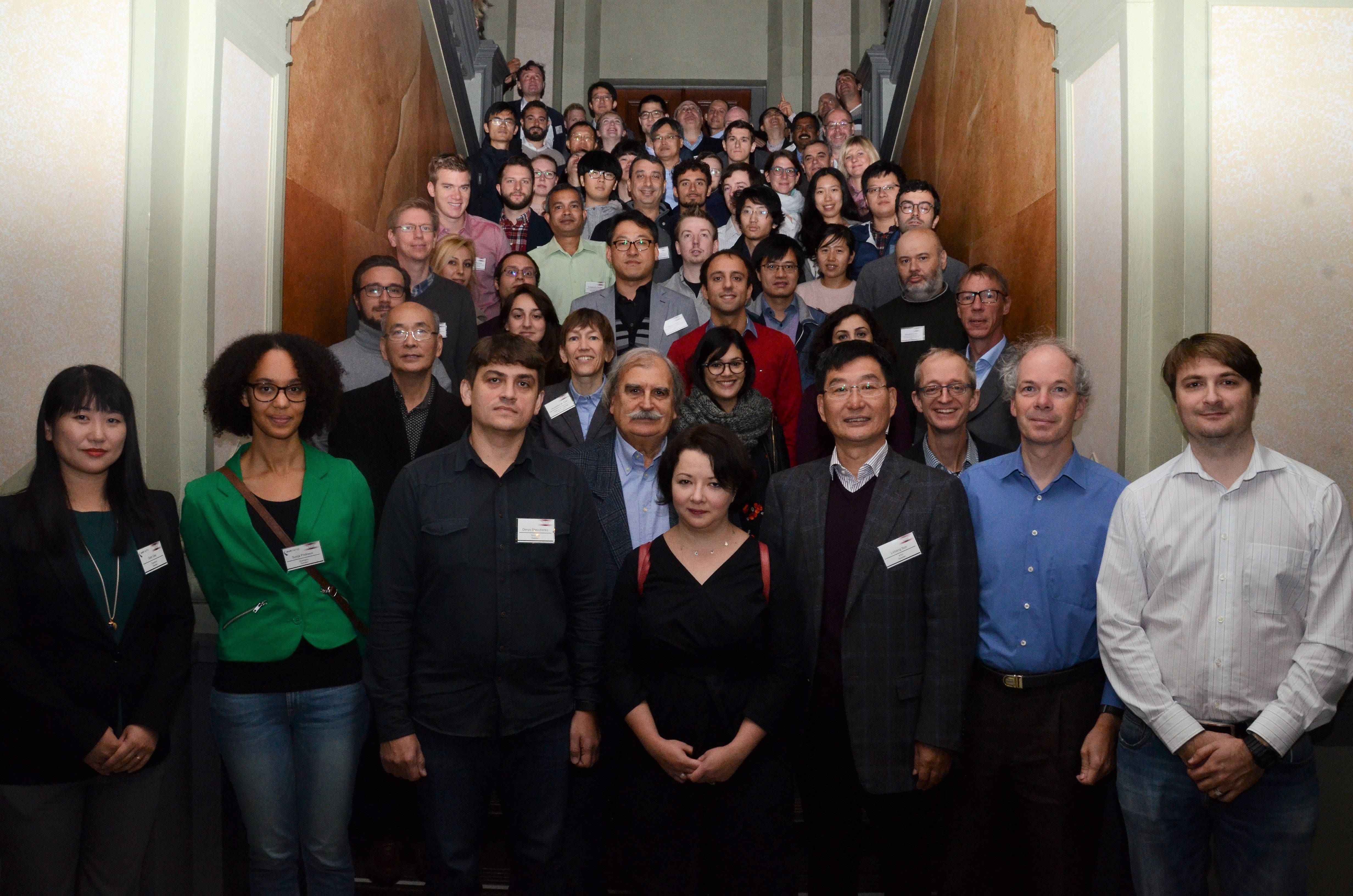
2017-10-23
Organizational announcements
We are pleased to announce that Sonja Prideaux has joined Dyenamo. Sonja is well-known to the Dyenamo team, as she was helping us out in parallel to her studies in chemical engineering at KTH in Stockholm. After completing her studies in the summer of 2017, she immediately joined Dyenamo. Many of you know her as conference coordinator for "DSSC strikes back". However, this was a temporary sidetrack from her engagement as Production Scientist and Sales Representative at Dyenamo.
We are also pleased to announce that Dr. Qian Gao has been appointed Sales Manager of China.
2017-09-29
Dyenamo launches new hole transport material: X55 (DN-X07)
We now launch our latest high-performance hole conductor DN-X07, also known as X55. This spiro[fluorene-9,9'-xanthene] (SFX) based material has been used to obtain perovskite solar cell device efficiencies of up to 20.8% by KTH, Stockholm in collaboration with EPFL, Switzerland (DOI: 10.1016/j.chempr.2017.03.011). For more information, please visit the product description.
2017-07-25
Great response to Dyenamo DSSC conference in Uppsala 16-17 October 2017
Organizing a DSSC conference was not an obvious decision for Dyenamo. It was triggered by the fact that we sensed an upcoming DSSC trend in combination with the lack of an active forum to meet. We can now conclude that this was a correct analysis and we are pleasantly surprised by the fact that we have received >60 abstracts. We could thus easily have organized a longer conference.
We are pleased to announce three additional keynote speakers; Md. K. Nazeeruddin from EPFL, Peng Wang from Zhejiang University and Kyusoon Shin from Dongjin Semichem.
As a result of the high numbers of abstracts, there was a sharp cut for oral presentations. However, it also means that there will be an excellent poster session. The oral and poster contributions have been selected and the responsible people have been informed. The program will be presented on this website within shortly. Please remember to register before 15 August as the fee thereafter will be increased.
We are also very pleased to see that the registrations for the Dyenamo training and coaching day are coming in.
2017-05-04
Low-power DSSC device with 28.9 % conversion efficiency at 1000 Lux using Dyenamo chemistry
Researchers at EPFL have obtained highly impressive power output values at indoor low-light levels indicating that Cu-based DSSC is the best performing indoor light harvesting system of all PV technologies (Freitag et al., Nature Photonics | DOI: 10.1038/nphoton.2017.60). This opens for a massive market related to IoT (Internet of Things) applications. Dyenamo is happy to have contributed to this pioneering work. The key dyes and electrolyte redox mediators are available among our standard dyes and Cu-materials.
2017-03-06
Dyenamo product drastically improves cell efficiency
In research led by Gerrit Boschloo it was found that addition of the small electron donor DN-X04 (TPAA) to a standard cobalt-based electrolyte can lead to a large improvement of the performance of dye-sensitized solar cells. This work was recently published in Nature Communications (Nature Commun. 7 (2016) 13934 | DOI: 10.1038/ncomms13934 ).
2017-01-24
Dyenamo signs mutual distribution agreement with Everlight
We are happy to annouce that Dyenamo and Everlight Chemical have signed mutual distributors agreements. This means that Dyenamo will be European distributor for Everlight's DSSC chemicals, including the hole-conductor Eversolar® Spiro-OMeTAD, and that Everlight will be Asian distributor (India excluded) for Dyenamo DSSC-materials. This will open new market channels and broaden the selection of DSSC products for both companies.
2016-11-29
Five new Cu-complexes for high-performance DSSC electrolytes
The development of Cu-based electrolytes for DSSCs is rapidly progressing. As part of Dyenamo's mission to give you access to cutting edge R&D materials, we are happy to present five new complexes. Thanks to the "dmby" and "tmby" ligands, a wider range of redox potentials are now available. Please check our product line for Cu-complexes for more details. The new complexes are available under the product-codes DN-Cu08 to DN-Cu12.
2016-11-21
Dyenamo launches portable economic measurement system
DN-AE04 is a computer-controlled electronic load especially designed for IV-characterization of high current devices such as solar cells, fuel cells and batteries. The portable product comes in three different configurations, the most powerful configuration allowing currents of up to 20 A. For more details, click here.
2016-11-08
Tailor-made training in Stockholm
The past few weeks, Dyenamo has been hosting an Indonesian scientific delegation in Stockholm. The scientists from the Indonesian Institute of Science (LIPI), Bandung Institute of Technology (ITB), Gajah Mada University (UGM) and Sebelas Maret State University (UNS) were trained/coached to strengthen their R&D activities on dye-sensitized and perovskite solar cells. Dyenamo provided a tailor-made program including lectures by the Dyenamo staff and co-founders, practical demonstrations and workshops as well as visits to the Dyenamo facilities.
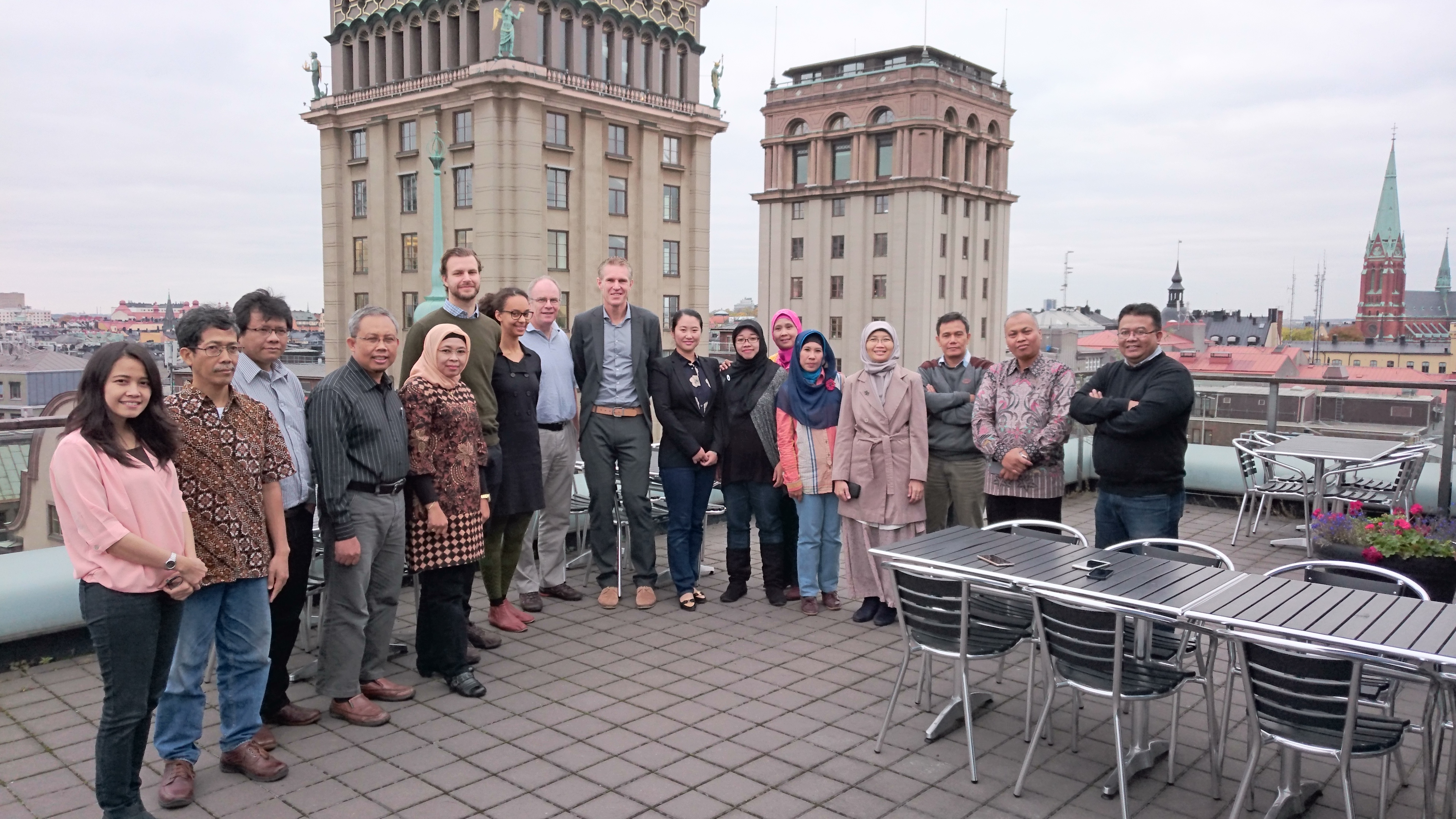
Indonesian scientific delegation and Dyenamo staff and lecturers from left to right:
Putri Nur Anggraini (LIPI), Shobih (LIPI), Dr. Rachmat Hidayat (ITB), Dr. Kuwat Triyana (UGM), Lia Muliani Pranoto (LIPI), Erik Gabrielsson, Sonja Prideaux, Anders Hagfeldt, Henrik Pettersson, Qian Gao, Dr. Natalita Maulani Nursam (LIPI), Erlyta Septa Rosa (LIPI), Lilis Retnaningsih (LIPI), Dr. Rike Yudianti (LIPI), Jojo Hidayat (LIPI), Dr. Agus Supriyanto (UNS), and Dr. Goib Wiranto (LIPI)
2016-10-05
PTAA for perovskite cells
In last week's Science paper (DOI: 10.1126/science.aah5557), EPFL in Switzerland has shown that PTAA (Poly[bis(4-phenyl)(2,4,6-trimethylphenyl)amine]) plays an important part in making highly stable perovskite solar cells by preventing metal atoms from the electrode from diffusing into the perovskite. Polymer-coated cells maintained 95% of their initial performance at 85°C for 500 hours under full solar illumination and maximum power point tracking. Dyenamo's long-chained PTAA molecular weight (22000 g/mol) is optimized for the high conductivity required in perovskite solar cells.
2016-09-21
Dyenamo agreement with Elixir Technologies for Indian market
Dyenamo is happy to announce that our collaboration with Elixir Technologies has been formalized. As a result of this, Elixir takes care of the Dyenamo business in India. The picture shows the CEOs of the two companies; Rao Raghuvamshi and Henrik Pettersson, during their meeting in Stockholm.
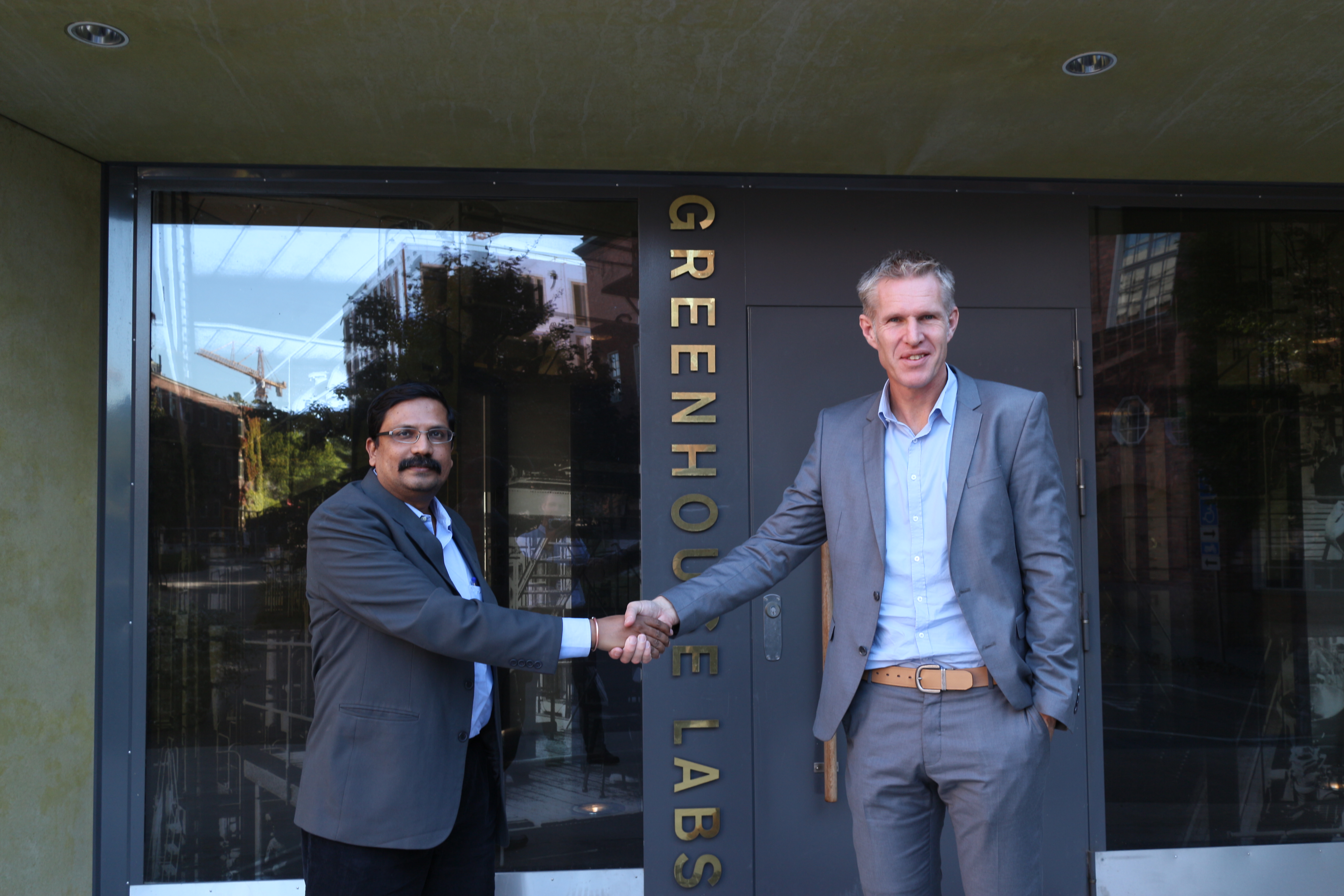
2016-09-20
Dyenamo co-founder Anders Hagfeldt receives prestigious award
We are proud to announce that Anders Hagfeldt has been awarded with the "Björkenska Prize" from Uppsala University. This is the finest Prize at the University and has been annually awarded since 1902.
2016-09-08
Record-efficiency for Cu-based DSSC
Dyenamo has in collaboration with the Royal Institute of Technology (KTH) developed a new Cu-based redox-couple, which has been used to obtain cell efficiencies up to 10 % (DOI: 10.1039/C6TA06782D). A key development is that the new complex features an innovative bis(2-pyridyl)ethane ligand in place of the nearly ubiquitous dimethylphenanthroline (dmp) ligand. These materials are now available in our product line for Cu-complexes.
2016-08-22
Dyenamo launches multifunctional holder for photo-electrochemistry
Dyenamo's multifunctional photo-electrochemistry (PEC) H-type (HT) tandem-holder has been designed to improve and facilitate your solar fuel experiments. However, the holder can also be used for other experiments, such as spectro-electrochemistry, electrolysis and light-driven organic synthesis. For more information, visit our new section here.
2016-07-25
Prolongation of temporary offers
As a result of our successful HOPV conference campaign, we prolong the promotion on a set of material-components for perovskite and dye-sensitized solar cells. The temporary offers are valid until 30 September 2016 and can be found on our temporary offers page.
2016-07-20
Dyenamo launches products for improved perovskite solar cell stability
Our two novel products DN-P12 (Methylammonium thiocyanate) and DN-P13 (Formadinium thiocyanate) can be used as additives/dopants to the perovskite composition for improved device stabilty.
2016-06-22
Successful campaign results in reduced prices on persovskite products
As a result of our successful campaign on perovskite precursors, the temporary offer prices now turn into our standard ones. Please see the present perovskite products and prices on our perovskite solar cells page.
2016-06-22
New temporary offers
Starting at the HOPV conference in Wales on the 28th of June to the 1st of July 2016, Dyenamo promotes a set of material-components for perovskite and dye-sensitized solar cells. The temporary offers are valid until 31 July 2016 and can be found on our temporary offers page.
2016-06-13
Dyenamo launches improved blue DSSC dye "Dyenamo Blue 2016"
We have developed an improved version of the blue dye DN-F10 (Dyenamo blue). The novel blue dye DN-F10M (Dyenamo Blue 2016) is more cost-efficient in production and thus offered at a lower price and in larger quantities than DN-F10. For further description of the dye, please visit the product description.
2016-06-10
Meet us at HOPV16
Dyenamo will have an exhibition stand at the HOPV16 conference (28 June-1 July 2016) in Swansea, Wales. We hope you will use this opportunity to learn more about our activities.
2016-06-08
Dyenamo launches a second low-cost high-performance hole-conductor
We are pleased to launch the hole-conductor DN-X03, also known as X59. It is a modification of our hole-conductor DN-X02 (X60), designed for even lower manufacturing costs. The material has been used to obtain solar cell efficiencies around 20 % (Dongqin Bi, et al., DOI:10.1016/j.nanoen.2016.03.020), i.e. as for DN-X02, this is a hole-conductor material competitive to Spiro-OMeTAD in device performance. Dyenamo sells the material in three batch sizes; 100 g for 52 900 SEK, 10 g for 8 900 SEK and 1 g for 1 700 SEK, all prices excluding VAT and transport. Larger batches can be obtained on demand. More information at Hole Transport Materials.
2016-03-25
Organizational announcement
We are pleased to announce that Dr. Qian Gao has been engaged as Production Scientist in Dyenamo. Qian has been working within the Centre for Molecular Devices for several years and is thus well-known to the Dyenamo team.
2016-03-09
Record-values for water-based DSSC using Dyenamo-materials
Researchers at Uppsala University (Ellis, et al., DOI: 10.1039/C6CP00264A) have obtained 5.7% efficiencies at full sun with aqueous DSSC using Dyenamo's new water-based chemistry, i.e. an electrolyte based on the cobalt-salts DN-C19 and DN-C20 in combination with the organic dye DN-F05M. To the best of our knowledge, this is the highest efficiency to date for aqueous DSSC.
2016-03-03
Dyenamo launches water-soluble Cobalt-complexes and organic dyes for aqueous DSSC
Our six new Cobalt-complexes are water-soluble and suitable for e.g. high-performance water-based DSSC electrolytes. For further information, please visit the product descriptions. Our novel organic dyes DN-F05M and DN-F04M are modifications of the dyes DN-F05 (D35cpdt/LEG4) and DN-F04 (D35) for efficient use in aqueous DSSC.
2016-02-29
New building block products
We have introduced new building block products for efficient construction of dyes, solar fuel materials, catalysts etc. For further information, please visit the product descriptions.
2016-02-23
Dyenamo launches low-cost high-performance hole-conductor
We are pleased to launch the hole-conductor DN-X02, also known as X60. It has been developed by the research group of Prof. Licheng Sun at KTH in Stockholm and implemented in top-effiiency devices by the groups of Profs. Anders Hagfeldt and Michael Grätzel at EPFL. The material has been used to obtain solar cell efficiencies around 20 % (DOI: 10.1039/C6EE00056H), i.e. this is a hole-conductor material that is competitive to Spiro-OMeTAD in device performance. Dyenamo sells the material in three batch sizes; 100 g for 61 900 SEK, 10 g for 9 900 SEK and 1 g for 1 900 SEK, all prices excluding VAT and transport. Larger batches can be obtained on demand. More information at Hole Transport Materials.
2016-02-01
Dyenamo laboratories visited by the Swedish Minister of International Development Cooperation
Friday 22 January, the Dyenamo laboratories were visited by Mrs Isabella Lövin, the Swedish Minister of International Development Cooperation, and her delegation. After a company presentation, the delegation was guided through our facilities.
2015-12-10
Dyenamo DN-P04 used in world-record perovskite solar cells
Dyenamo's Co-dopant DN-P04 (FK209) was used in the perovskite solar cell made by EPFL that in certified measurements delivered 21.02 % efficiency, i.e. a new efficiency world-record for the technology.
2015-12-08
Dyenamo laboratories visited by the President of Islamic Republic of Afghanistan
Last Friday, the Dyenamo laboratories were visited by the President of Islamic Republic of Afghanistan, H.E. Dr Mohammad Ashraf Ghani, and his delegation. After a company presentation by our CEO, Henrik Pettersson, the delegation was guided through our facilities by our CTO, Erik Gabrielsson.
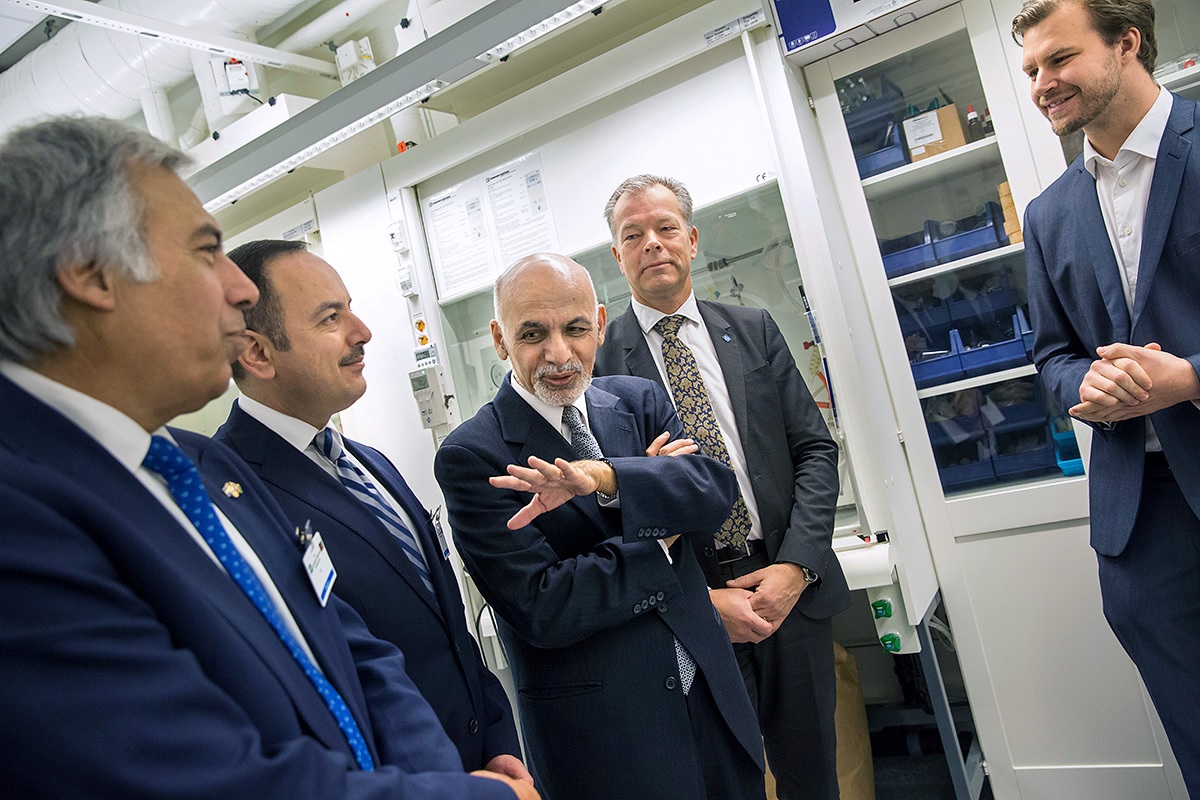
2015-09-18
Dyenamo DN-F05 used in high-efficiency cells
Dyenamo´s dye LEG4 (D35cpdt, DN-F05) has been used as co-sensitizer in DCCS devices with reported efficiency values exceeding 14%, see K. Kakiage, Y. Aoyama, T. Yano, K. Oya, J. Fujisawa and M. Hanaya, Chem. Commun., 2015, DOI: 10.1039/C5CC06759F. For the record efficiency, Co-phenanthroline complexes were used as redox mediator, see Dyenamo products DN-C07 and DN-C08 .
2015-09-16
Dyenamo yellow improves perovskite solar cells
Doctorbladed perovskite solar cells on conducting polymer substrate showed a marked increase in performance, when a small organic dye molecule was added to the polymer solution (Y. Deng et al., Energy Environ. Sci., 2015, 8, 1544). The molecule in question is
(z)-2-cyano-3-(4-(diphenylamino)phenyl)acrylic acid), also known as L0 or Dyenamo yellow (DN-F01). The effect was attributed to the improved wetting of the perovskite solution on the polymer layer: Dyenamo yellow makes the polymer layer more polar.
|

